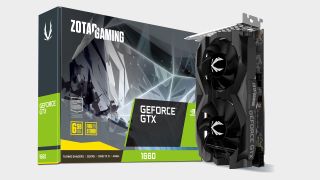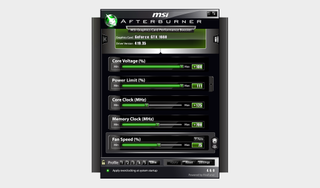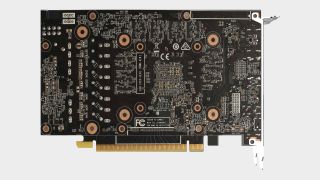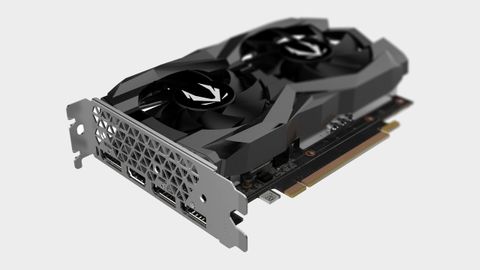Our Verdict
The GeForce GTX 1660 continues the downward price and performance trend with Nvidia's Turing architecture, cutting additional high-end features to bring a generational improvement to the mainstream market.
For
- Great for 1080p gaming
- Very affordable
- Efficient and quiet
Against
- Modest gains over 1060 6GB
- Not a true budget GPU price
- Some games use more than 6GB
PC Gamer's got your back
Architecture: TU116
Lithography: TSMC 12nm FinFET
Transistor Count: 6.6 billion
Die Size: 284mm2
SMs: 22
CUDA Cores: 1,408
Render Outputs: 48
Texture Units: 88
Base Clock: 1530MHz
Boost Clock: 1785MHz
FP32 GFLOPS: 5,027
Memory Speed: 8 GT/s
Bus Width: 192-bit
GDDR6 Capacity: 6GB
Memory Bandwidth: 192GB/s
TDP: 120W
Price: $219
Nvidia's TU116 GPU raises the question of just how far down Nvidia can go with the Turing architecture. The first slate of Turing GPUs are the best graphics cards around, featuring real-time ray tracing and deep learning cores, but the TU116 used in the GTX 1660 Ti cut those in order to target a more mainstream price. The GTX 1660 trims things even more by opting for readily available (ie, cheaper) GDDR5 memory instead of GDDR6. Along with fewer CUDA cores and other elements, the result is exactly what you'd expect: a slightly slower but even more affordable GPU.
Getting more performance at a lower price is great, but with graphics cards there's always a problem of competing with the previous generation. The GTX 1660 will be faster than the GTX 1060 6GB—it has some architectural enhancements, higher clockspeeds, and more shader cores—but it's not going to be a massive upgrade. That's why I generally recommend trying to skip a generation or two of hardware between upgrades, especially for budget and mainstream gamers, which means the GTX 1660 is better positioned as a replacement for an old GTX 960 or earlier GPU. If you're using such a card, the 1660 is a great upgrade, while anyone with a GTX 970 or better will probably want to wait a bit longer (or go with a faster and more expensive GPU like the GeForce RTX 2060).
The GPU at the heart of the GTX 1660 is the same TU116 as in the 1660 Ti, only with two of the SMs disabled, which in turn disables 128 CUDA cores and 8 texture units. Perhaps more interesting is when you look at the GPU and compare it with the GP106 used in the GTX 1060. Transistor counts increased from 4.4 billion to 6.6 billion, and die size also went up from 200mm^2 to 284mm^2. I've said it before, but TSMC's 12nm in practice doesn't appear to be much more than a refinement of its 16nm tech—what Intel would have called 16nm+. Nvidia should see much bigger gains when it eventually moves to TSMC's 7nm node, but we'll have to wait a while before that happens.
With 50 percent more transistors than GP106 but only 20 percent more CUDA cores, we also get some idea of how many changes went into the Turing architecture. Improved color compression, fast FP16 support, variable rate shading, and concurrent FP and INT pipelines are all present, though how much they improve performance varies by game—and right now, no games use FP16 to improve performance (it was in Far Cry 5 but later removed). Also note that some of the extra transistors are likely there for GDDR6 memory support. While both the GTX 1660 and 1660 Ti have 6GB VRAM, GDDR5 and GDDR6 are not pin compatible, which means the memory controller needs to support both.

Nvidia doesn't have reference designs (aka Founders Editions) for its lower tier products, which means all of the cards are 'custom' designs of various forms. Zotac was the first company to get me a GTX 1660 for review, and unlike the GTX 1660 Ti samples I tested, this card sports reference clocks. There will certainly be factory overclocked models, from Zotac as well as the other AIB partners, but here at least we can see the baseline level of performance.
The Zotac Gaming GTX 1660 is nothing fancy, though it does have dual fans for cooling. Despite the two fans, it's basically a mini-sized card that can easily fit in smaller cases, measuring just 173mm (6.83 inches) in length. Like nearly all modern graphics cards, it's a dual-slot design, and while it's technically not required, the card uses a single 8-pin PEG power connector. (That's per Nvidia's specs, incidentally, probably to err on the side of caution: a single 6-pin PEG connector plus an x16 PCIe slot should provide up to 120W, but by using an 8-pin connection Nvidia can ensure cards don't exceed the PCIe slot's power capacity.)
For video outputs, Zotac provides one HDMI 2.0b port along with three DisplayPort 1.4 ports, and it can run all four outputs simultaneously. If you have an older monitor that requires a DVI-D connection, you'll have to bring your own adapter to the party. There are no RGB LEDs, or any lights for that matter, no dual VBIOS chips, or really any other higher end features. That's fine with me, though, since anyone looking for such features would usually be better off spending more money and grabbing a GTX 1660 Ti or RTX 2060. This is a no-frills card that provides everything you need, at Nvidia's base $219 price.

GeForce GTX 1660 Overclocking
Since this particular card doesn't come with any fancy extras, it's also a good candidate to show how much overclocking headroom exists for enthusiasts GPU. The boost clock is nominally 1785MHz, but Nvidia's GPUs for the past several generations have rarely run at clocks below that level, often far exceeding the boost clock in games (though not necessarily in GPU compute workloads). During testing, at stock clocks the GTX 1660 runs at speeds of 1845-1905MHz, with temperatures of up to 67C. System power draw is only 250W, but at least half of that comes from the motherboard, CPU, RAM, and other components—and that's not accounting for PSU inefficiency, which would be actual power draw at 225W, so the GTX 1660 is likely running well under its 120W TDP rating.
For overclocking, I set the core voltage slider to +100 in MSI Afterburner, increased the power limit to 111 percent, and increased the fan speed to 75 percent. Then I looped the 3DMark Time Spy stress test while I tweaked the VRAM and core clocks.
The GTX 1660 uses GDDR5 memory, so it's not going to come anywhere near matching a 1660 Ti. (I was able to go from 12GT/s to 15GT/s on the Asus 1660 Ti, and 14.7GT/s on an EVGA 1660 Ti.) With the Zotac GTX 1660, I was able to push the GDDR5 from 8GT/s to 9.4GT/s (+700MHz), a 17.5 percent increase. Meanwhile on the GPU clock, I was only able to add 125MHz, which resulted in stable clockspeeds of 1950-2010MHz in games, a 5-6 percent improvement. Combined, performance in games with the overclocked GPU is about 10 percent faster than at stock.
Individual results will vary from that a bit, but it's a reasonable baseline estimate. There will likely be factory overclocked models that will run about 5 percent faster on the core clock, and the better models will hit slightly higher speeds, but I wouldn't recommend spending too much extra for such a card. The GTX 1660 does best when prices are kept closer to $200 than $250—because at $250, you're probably better off just moving up to a GTX 1660 Ti.

GeForce GTX 1660 Performance
For this review, I'm using a revised list of games—basically, I dropped several games that were getting a bit old, and have replaced them with newer releases (eg, Hitman 2 replaced Hitman (2016). The Division 2 is the latest addition, making for a lucky 13 games tested. I've also retested Deus Ex, Fortnite, and Hitman 2 in the past week to correct some anomalies. The GTX 1660 is running Nvidia's latest 419.35 drivers, a custom build provided for reviewers in advance of the launch. Other Nvidia cards are mostly running 148.91 drivers (except for in the latest additions just noted), while AMD cards are mostly tested with 19.2.1 or later drivers (19.3.1 for the latest retests/additions).
My GPU test system uses a Core i7-8700K overclocked to 5.0GHz to help minimize CPU bottlenecks during testing, along with other high-end components. You can see the full details in the boxout on the right (if you're not running AdBlock). For budget and midrange graphics cards, the test system is perhaps overkill, but this allows all the graphics cards to reach their full performance potential.
Testing is conducted at 1080p 'medium' quality, along with 'ultra' quality at 1080p, 1440p, and 4k. In most games the ultra preset maxes out all the options, while in games that don't include presets I've manually maxed out the settings (eg, GTA5's advanced graphics menu, other than superscaling). Some games punish cards with less than 6GB or even 8GB of VRAM at these settings, but in general the GTX 1660 should be fine. I'm only going to include the summary chart for 4k, as that's definitely not a reasonable target for this GPU.

Swipe left/right for additional charts

Swipe left/right for additional charts

Swipe left/right for additional charts

Swipe left/right for additional charts

Swipe left/right for additional charts

Swipe left/right for additional charts

Swipe left/right for additional charts

Swipe left/right for additional charts

Swipe left/right for additional charts

Swipe left/right for additional charts

Swipe left/right for additional charts


Swipe left/right for additional charts

Swipe left/right for additional charts

Swipe left/right for additional charts

Swipe left/right for additional charts

Swipe left/right for additional charts

Swipe left/right for additional charts

Swipe left/right for additional charts

Swipe left/right for additional charts

Swipe left/right for additional charts

Swipe left/right for additional charts

Swipe left/right for additional charts

Swipe left/right for additional charts

Swipe left/right for additional charts

Swipe left/right for additional charts

Swipe left/right for additional charts

Swipe left/right for additional charts
Starting at 1080p medium, performance of the GTX 1660 is good. It's about 12 percent faster than the outgoing GTX 1060 6GB, so nothing major, but at least it's both faster and less expensive. It's also 20 percent faster than the 1060 3GB, 35 percent faster than a GTX 970, and over twice as fast as a GTX 1050. Note that when the 1050 came out, performance was also nearly identical to the GTX 960 2GB, so if you're holding onto an older GPU there's definitely potential for a good performance boost.
Looking elsewhere, the GTX 1660 Ti is 15 percent faster than the 1660, mostly thanks to its higher memory clocks. AMD meanwhile pretty much matches the 1660 in performance with the RX 590, though it's a less efficient card (the RX 590 draws around 50W more power while gaming.) That also means the 1660 is 11 percent faster than the RX 580 8GB, and 25 percent faster than the RX 570 4GB—though obviously at a higher price right now.
Moving to 1080p ultra doesn't change things much, though the 1660 tends to do slightly better by a few percent in each of the above comparisons (other than the 1660 Ti, which increases its lead by 1 percent). There are a few games where the GTX 1660 isn't able to average 60fps or more, but that's only in notoriously punishing games like Deus Ex Mankind Divided, Assassin's Creed Odyssey, and Metro Exodus. Overall, it's a very capable 1080p gaming card—better than the 1060 6GB that launched a couple of years back, but not tremendously so.

Swipe left/right for additional charts

Swipe left/right for additional charts

Swipe left/right for additional charts

Swipe left/right for additional charts

Swipe left/right for additional charts

Swipe left/right for additional charts

Swipe left/right for additional charts

Swipe left/right for additional charts

Swipe left/right for additional charts

Swipe left/right for additional charts

Swipe left/right for additional charts

Swipe left/right for additional charts

Swipe left/right for additional charts

Swipe left/right for additional charts

Swipe left/right for additional charts
1440p ultra is mostly a miss for the GTX 1660. Some games like Forza Horizon 4 can break 60fps, but most games will run at closer to 45fps. Dropping the image quality a few notches can get the card back to 60fps if you want, but I think it's better to stick with 1080p. 4k ultra meanwhile is basically out of the question, with Forza Horizon 4 being the best result at 45fps. Battlefield 5 and Strange Brigade land right near 30fps, and everything else is in the 20s or lower. The 6GB VRAM also becomes an issue with 4k ultra, and several games are clearly running out of VRAM and being forced to swap data out to system RAM.

Swipe left/right for additional charts

Swipe left/right for additional charts

Swipe left/right for additional charts

Swipe left/right for additional charts

Swipe left/right for additional charts

Swipe left/right for additional charts
Combine the performance with the price, and you end up with a nice mainstream graphics card. The GTX 1660 isn't going to beat the RX 580 8GB or 570 4GB on value, not with the current prices, but it's not far off. Note also that the 10-series GPUs are likely to become more difficult to find at decent prices now that the GTX 1660/Ti and RTX cards are shipping, so while I wouldn't necessarily recommend upgrading from a 10-series card yet, if you're putting together a new gaming PC the GTX 1660 is a great option.

The GeForce GTX 1660: a good if unsurprising mainstream card
As you move from extreme to high-end to mainstream and budget GPUs, prices became far more attractive almost in proportion to the drop in performance. If you already have a high-end graphics card, even a card that's several years old like a GTX 980, the GTX 1660 isn't going to excite. Instead, it's all about going mainstream.
Look at the Steam Hardware Survey and it's immediately clear that graphics cards priced at $250 and below rule the roost. The GTX 1060, 1050 Ti, and 1050 account for more than 30 percent of all graphics cards in the survey, while the GTX 1080, 1080 Ti, and all of the GeForce RTX models combined comprise less than 6 percent of the market. Steam's survey may not be a perfect view of the gaming market, but it's the best we have for now, and it highlights how popular inexpensive GPUs are.
The GTX 1660 takes over for Nvidia as the new "sweet spot" for mainstream GPUs. Nvidia told me that's also why the cards use GDDR5—supply and pricing on GDDR5X and GDDR6 apparently "wasn't enough" to meet the expected demand. And there's a large chunk of PC gamers running far less capable hardware, so anyone with a GTX 960 or lower may finally be tempted to make the switch. Or not, since it's still only a minor bump in performance relative to the GTX 1060 6GB for only a slightly better price. If the 1060 didn't convince you to upgrade over two years ago for $250, I can't imagine 10-15 percent more performance for $30 less being the tipping point.
Rather than upgrades, I think the biggest draw for the GTX 1660 will be with new PC builds—newcomers looking to put together a capable budget gaming PC will find plenty to like with this card. It's not going to bring home any pink slips in a race, but if all you're looking for is a good 1080p gaming experience, this will do.
The GeForce GTX 1660 continues the downward price and performance trend with Nvidia's Turing architecture, cutting additional high-end features to bring a generational improvement to the mainstream market.
Jarred's love of computers dates back to the dark ages when his dad brought home a DOS 2.3 PC and he left his C-64 behind. He eventually built his first custom PC in 1990 with a 286 12MHz, only to discover it was already woefully outdated when Wing Commander was released a few months later. He holds a BS in Computer Science from Brigham Young University and has been working as a tech journalist since 2004, writing for AnandTech, Maximum PC, and PC Gamer. From the first S3 Virge '3D decelerators' to today's GPUs, Jarred keeps up with all the latest graphics trends and is the one to ask about game performance.
